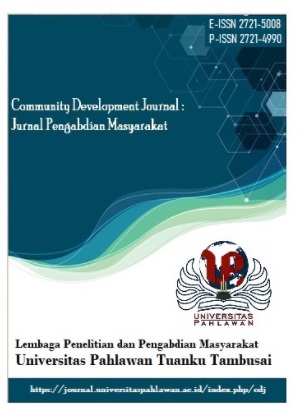EVALUASI PROGRAM ROOTS MODEL KIRKPATRICK SEBAGAI PENCEGAHAN BULLYING DI SEKOLAH PENGGERAK KOTA BANJARBARU KALIMANTAN SELATAN
DOI:
https://doi.org/10.31004/jrpp.v6i4.21361Keywords:
Evaluasi, Bullying, KirkpatrickAbstract
Penelitian ini merupakan model evaluasi pelatihan Kirkpatrick yang berfokus untuk mengevaluasi perilaku bullying yang dilakukan siswa pada tahun-tahun sebelumnya; siswa yang menjadi korban bullying pada tahun sebelumnya; peran siswa lain yang mencoba menghentikan bullying; dan rasa takut siswa terhadap bullying di sekolah Analisis data yang digunakan adalah deskriptif kuantitatif. Data yang diperoleh dari hasil pelaksanaan kuesioner merupakan data kuantitatif. Hasil penelitian menunjukkan bahwa perilaku bullying siswa di sekolah pada tahun sebelumnya adalah 5 siswa (36%) yang tidak pernah melakukan bullying di sekolah. Adapun 9 siswa (64%) pernah melakukan bullying dengan frekuensi yang relatif rendah. Korban bullying pada tahun sebelumnya mencapai 64 % yang terdiri dari 4 siswa laki-laki dan 5 siswa Perempuan. Peran teman dalam menghentikan bullying telah terjadi di dalam pertemanan siswa paling tinggi dalam dua sampai dengan tiga kali dalam sebulan yakni mencapai 64 % atau 9 siswa. Rasa takut siswa terhadap bullying di sekolah mmenunjukkan bahwa 5 orang siswa (36%) siswa tidak pernah merasa takut mendapatkan bullying di sekolah..References
Ahmed, I., Qazi, T. F., Jabeen, S., & Punjab, P. (2011). Self-Efficacy: The Predictor of Educational Performance among University Students. In Information Management and Business Review (Vol. 3, Issue 2).
Akasyah, W., Margono, H. M., & Efendi, F. (2019). Bullying Victimisation Effect at Physical, Phychological, and Social in Adolescence - A Systematic Review. 538–546. https://doi.org/10.5220/0008328205380546
Akman, Y. (2021). The Relationship between School Climate and Students’ Aggressive Behaviors. International Journal of Progressive Education, 17, 2021. https://doi.org/10.29329/ijpe.2020.332.26
Byers, D. S., Mishna, F., & Solo, C. (2019). Clinical Practice with Children and Adolescents Involved in Bullying and Cyberbullying: Gleaning Guidelines from the Literature Custom Citation. https://repository.brynmawr.edu/gsswsr_pubs/88
Coelho, V. A., & Sousa, V. (2020). Bullying and Cyberbullying Behaviors Questionnaire: Validation of a short form. International Journal of School and Educational Psychology, 8(1), 3–10. https://doi.org/10.1080/21683603.2018.1522282
Darling-Hammond, L., & Cook-Harvey, C. M. (2018). Educating the Whole Child: Improving School Climate to Support Student Success. Learning Plolicy Institute. https://learningpolicyinstitute.org/product/educating-whole-child.
Fathona Handayani, N. (2019). I CARE Training to Increase the Self-Efficacy and Prosocial Behavior of Students Observers of Bullying.
Fitrawan, M. R. (2018). Kecam Kekerasan Anak di Banjarbaru yang Viral di Medsos, Dewan: Stop Bullying Artikel ini telah tayang di Apahabar.com Banjarmasin dengan judul: Kecam Kekerasan Anak di Banjarbaru yang Viral di Medsos, Dewan: Stop Bullying. Apahabarbanjarmasin. https://banjarmasin.apahabar.com/post/kecam-kekerasan-anak-di-banjarbaru-yang-viral-di-medsos-dewan-stop-bullying-l798r30e
Giavrimis, P. E. (2020a). School bullying. Teacher interpretation schemes and conceptualizations. International Journal of Sociology of Education, 9(3), 325–347. https://doi.org/10.17583/rise.2020.5319
Giavrimis, P. E. (2020b). School bullying. Teacher interpretation schemes and conceptualizations. International Journal of Sociology of Education, 9(3), 325–347. https://doi.org/10.17583/rise.2020.5319
Gomez?baya, D., Garcia?moro, F. J., Nicoletti, J. A., & Lago?urbano, R. (2022). A Cross?National Analysis of the Effects by Bullying and School Exclusion on Subjective Happiness in 10?Year?Old Children. Children, 9(2). https://doi.org/10.3390/children9020287
Jennings, W. G., Song, H., Kim, J., Fenimore, D. M., & Piquero, A. R. (2019). An Examination of Bullying and Physical Health Problems in Adolescence among South Korean Youth. Journal of Child and Family Studies, 28(9), 2510–2521. https://doi.org/10.1007/s10826-017-0885-3
Jung, Y. A. (2018). What Makes Bullying Happen in School? Reviewing Contextual CharacteristicsSurrounding Individual and Intervention Programson Bullying. Elementary Education Online, 17(1), 1–6. http://ilkogretim-online.org.tr
Min, M., Anderson, J. A., & Chen, M. (2017). What Do We Know About Full-Service Community Schools? Integrative Research Review With NVivo. In School Community Journal (Vol. 27, Issue 1). http://www.schoolcommunitynetwork.org/SCJ.aspx
Mohan, T. A. M., & Bakar, A. Y. A. (2021). A systematic literature review on the effects of bullying at school. SCHOULID: Indonesian Journal of School Counseling, 6(1), 35. https://doi.org/10.23916/08747011
Montero-Carretero, C., Pastor, D., Santos-Rosa, F. J., & Cervelló, E. (2021). School Climate, Moral Disengagement and, Empathy as Predictors of Bullying in Adolescents. Frontiers in Psychology, 12. https://doi.org/10.3389/fpsyg.2021.656775
Qiu, H. (2021). Explore the Factors of School Bullying from the Ecosystem Theory. OALib, 08(12), 1–10. https://doi.org/10.4236/oalib.1108165
Saleem Khan, A., & Khalid, S. (2020). Saleem Khan Self-Efficacy Practicability in Students’ Scholastic Performance Ilkogretim Online-Elementary Education Online. Year, 19(4), 4588–4599. https://doi.org/10.17051/ilkonline.2020.04.764865
Sargioti, A., Kuldas, S., Foody, M., Viejo Otero, P., Kinahan, A., Canning, C., Heaney, D., & O’Higgins Norman, J. (2022). Dublin Anti-Bullying Self-Efficacy Models and Scales: Development and Validation. Journal of Interpersonal Violence. https://doi.org/10.1177/08862605221127193
Thornberg, R., Wänström, L., & Jungert, T. (2018). Authoritative classroom climate and its relations to bullying victimization and bystander behaviors. School Psychology International, 39(6), 663–680. https://doi.org/10.1177/0143034318809762
Wang, C., Ryoo, J. H., Swearer, S. M., Turner, R., & Goldberg, T. S. (2017). Longitudinal Relationships between Bullying and Moral Disengagement among Adolescents. Journal of Youth and Adolescence, 46(6), 1304–1317. https://doi.org/10.1007/s10964-016-0577-0
Waters, S., & Mashburn, N. (2017). An Investigation of Middle School Teachers’ Perceptions on Bullying. Www.Jsser.Org Journal of Social Studies Education Research Sosyal Bilgiler E?itimi Ara?t?rmalar? Dergisi, 2017(1), 1–34. www.jsser.org
Wulan, R., Sanjaya, W., & Raya, P. (2022). Developing Positive School Climate for Inclusive Education. Journal of Education for Sustainability and Diversity, 1(1), 54–72.
Downloads
Published
How to Cite
Issue
Section
License
Copyright (c) 2023 Ali Rachman, Akhmad Sugianto, Renandra Prayudy, M. Rico Ramadhan

This work is licensed under a Creative Commons Attribution-ShareAlike 4.0 International License.






